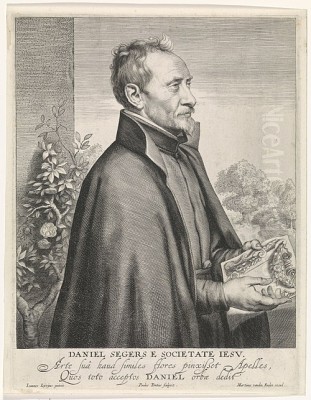
Daniel Seghers stands as a unique figure in the rich tapestry of 17th-century Flemish Baroque art. Born in Antwerp in 1590 and passing away in the same city in 1661, he achieved remarkable fame not only for his exquisite skill as a painter but also for his identity as a devout Jesuit lay brother. Specializing in floral still lifes, particularly the distinct genre of garland paintings, Seghers combined meticulous botanical observation with profound religious symbolism, creating works that were sought after by patrons across Europe, from royalty to high-ranking clergy. His art served both as devotional aids and as sophisticated diplomatic gifts, reflecting the intersection of faith, artistry, and politics in the Southern Netherlands during a period of intense religious and cultural activity.
Early Life and Artistic Formation in Antwerp
Daniel Seghers entered the world in Antwerp, the bustling artistic and commercial heart of the Spanish Netherlands. He was the eldest son of Pierre Seghers, a Catholic silk merchant, and Marguerite van Gheel. His early life was marked by change; following his father's death, the family, likely having adopted Calvinist beliefs temporarily for safety or opportunity, moved north to the Dutch Republic, settling in Utrecht around 1601. It was there that Seghers likely received his initial education. However, the pull of his native city and its vibrant art scene proved strong.
By 1605, the young Seghers had begun his artistic training. His path led him back to Antwerp, where the artistic environment was dominated by the towering figure of Peter Paul Rubens and the legacy of detailed realism. In 1611, Seghers was formally enrolled as an apprentice in the prestigious Guild of Saint Luke in Antwerp. Crucially, his master was Jan Brueghel the Elder, himself a renowned painter celebrated for his landscapes, allegorical scenes, and, significantly, his delicate flower paintings. This apprenticeship under Brueghel was fundamental in shaping Seghers' own specialization and technical refinement in depicting floral subjects.
A Vocation: Joining the Society of Jesus
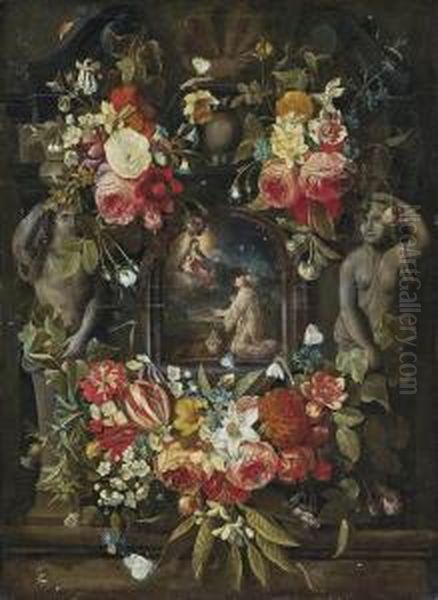
A pivotal moment in Seghers' life occurred in 1614 when he reconverted to Catholicism, the faith of his father. This spiritual reawakening led him to seek a deeper commitment, and in 1615, he entered the Society of Jesus as a lay brother. He completed his novitiate in Mechelen (Malines). His religious vocation did not mean an end to his artistic pursuits; rather, it profoundly shaped them. The Jesuit order recognized his exceptional talent and saw its potential for furthering the aims of the Counter-Reformation through devotional art.
Seghers spent approximately two years, likely between 1625 and 1627, serving his order in Rome. This period would have immersed him in the heart of the Catholic world and exposed him to the masterpieces of Italian art, potentially further refining his artistic sensibilities, although his core style remained rooted in the Flemish tradition. Upon his return to Antwerp, he settled into a life dedicated to both prayer and painting within the Jesuit house. From around 1625 onwards, he often signed his works "Daniel Seghers Societatis Jesu," explicitly linking his artistic identity with his religious affiliation.
The Art of the Flower Garland
While Seghers painted various forms of floral still lifes, including bouquets in vases, he became most famous for his mastery of the "flower garland" or "cartouche" painting. This genre, popularized in Antwerp partly through the work of his teacher Jan Brueghel the Elder, typically features a central image – often a religious scene, a portrait, a grisaille sculpture, or a devotional text – surrounded by an opulent wreath or swag of meticulously rendered flowers.
Seghers elevated this genre to new heights. His garlands are characterized by their astonishing botanical accuracy; each petal, leaf, and stem is rendered with painstaking detail and a sensitivity to texture. He depicted a wide variety of flowers, often showing species that bloomed at different times of the year together, creating an idealized, perpetually blooming vision of nature's beauty. His compositions are typically balanced and harmonious, with the flowers carefully arranged to create a sense of depth and rhythm around the central motif.
A hallmark of Seghers' style is his use of color and light. He often employed a dark, neutral background, which made the vibrant hues of the flowers – the rich reds of roses and carnations, the delicate blues of forget-me-nots, the bright yellows of tulips, the pure whites of lilies – stand out dramatically. His handling of light creates a sense of volume and presence, giving the flowers an almost tangible, sculptural quality. He also frequently included small insects like butterflies, dragonflies, beetles, and caterpillars among the blooms, adding touches of realism and further layers of symbolism.
A Spirit of Collaboration

The nature of garland painting often lent itself to collaboration, and Seghers worked with many of the leading figure painters of his time in Antwerp. While Seghers was the undisputed master of the floral elements, he relied on fellow artists to execute the central cartouches. This collaborative practice was common in the highly specialized Antwerp art world.
His most illustrious collaborator was undoubtedly Peter Paul Rubens, the preeminent figure of Flemish Baroque painting. Although documented collaborations are few, their association is known. More frequent were his partnerships with other respected artists. He worked extensively with Erasmus Quellinus II, a painter known for his classicizing style, on numerous pieces featuring the Madonna and Child or saints within Seghers' floral frames.
Other notable collaborators included Cornelis Schut, another prominent painter of large-scale religious and mythological scenes. Seghers partnered with Thomas Willeboorts Bosschaert, who painted figures in a style influenced by Anthony van Dyck, for works such as a garland surrounding a sculpted depiction of the Virgin. He also worked with Simon de Vos, known for his genre scenes and cabinet pictures, for instance on a piece commissioned for the Infanta Isabella Clara Eugenia.
The list extends further, including artists like Abraham van Diepenbeeck (a pupil and assistant of Rubens), Gonzales Coques (known for elegant portraiture), and Hendrick van Balen (a frequent collaborator with Jan Brueghel the Elder). Snippets also mention collaborations with Jan Pietersz. Coen, Jan van der Heyden (though primarily famous for cityscapes, suggesting perhaps occasional figure painting or a specific commission), Philip van Thiel (very likely his own pupil, Jan Philips van Thielen, who became a noted flower painter himself), and Jan Peterz. van der Heijen. These partnerships underscore Seghers' central role in the Antwerp art scene and the integrated nature of artistic production.
Flowers of Faith: Symbolism and Devotion
Seghers' paintings were far more than mere decorative arrangements of flowers. Imbued with his deep Jesuit faith and created within the context of the Counter-Reformation, his works are rich in symbolism. Flowers traditionally carried specific meanings: roses often symbolized the Virgin Mary (the "rose without thorns") or divine love, lilies represented purity, tulips could signify wealth or the transience of earthly beauty, while irises might refer to Christ's Passion or Mary's sorrows.
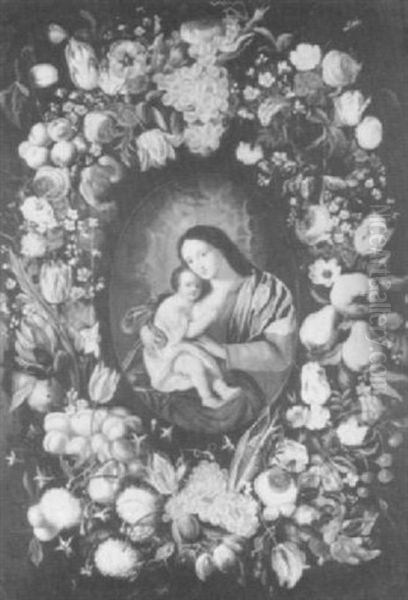
The inclusion of insects also added symbolic weight. Butterflies were often seen as symbols of the resurrected soul, while caterpillars could represent the earthly stage of life. Flies or decaying petals might serve as memento mori, reminders of the fleeting nature of life and beauty, urging contemplation of eternal matters. By surrounding sacred images or portraits with these carefully chosen, symbolically charged blooms, Seghers created objects intended for pious meditation. His art aimed to inspire devotion by presenting the beauty of God's creation intertwined with central tenets of Catholic faith. Compared to his teacher Jan Brueghel the Elder, Seghers often imbued his flowers with a greater sense of spiritual gravity and focused intensity.
An Artist Favored by Princes and Kings
Daniel Seghers' reputation extended far beyond the walls of Antwerp. His unique position as a Jesuit artist, combined with the sheer beauty and technical brilliance of his work, made his paintings highly desirable among the European elite. Since Jesuit rules typically forbade direct payment for his work, his paintings were often presented as prestigious gifts by the Jesuit order to influential patrons, rulers, and diplomats, serving to cultivate goodwill and showcase the cultural sophistication of the Catholic faith.
His patrons included Frederick Henry, Prince of Orange, the Stadtholder of the Dutch Republic, and his wife Amalia van Solms. For a garland painting surrounding their portraits, Seghers (or rather, the Jesuit order through his work) reportedly received valuable gifts in return, including a gold palette and maulstick, and gold crosses. His works were also sent to England, finding favor with King Charles I and, later, King Charles II.
He received commissions or sent works as gifts to figures like the Archduke Leopold Wilhelm, governor of the Spanish Netherlands, Cardinal-Infante Ferdinand of Austria, and Queen Christina of Sweden. The Spanish ambassador in The Hague, Manuel de Otondo, was another recipient of his religiously themed floral works. This network of high-profile patronage demonstrates the immense esteem in which Seghers was held and the diplomatic role his art played across the continent.
Signature Works and Artistic Practice
Among Seghers' many celebrated works, several stand out as representative of his style and collaborations. The Garland with the Virgin and Child housed in the Museo del Prado, Madrid, is a prime example, likely featuring a central image painted by one of his collaborators, framed by Seghers' exquisitely detailed flowers. Similar compositions, such as A Wreath of Flowers decorating a Sculpture of the Madonna and Child or Floral Wreath with Virgin and Child (often collaborations with Erasmus Quellinus II), showcase his ability to integrate the floral element seamlessly with the central devotional subject.
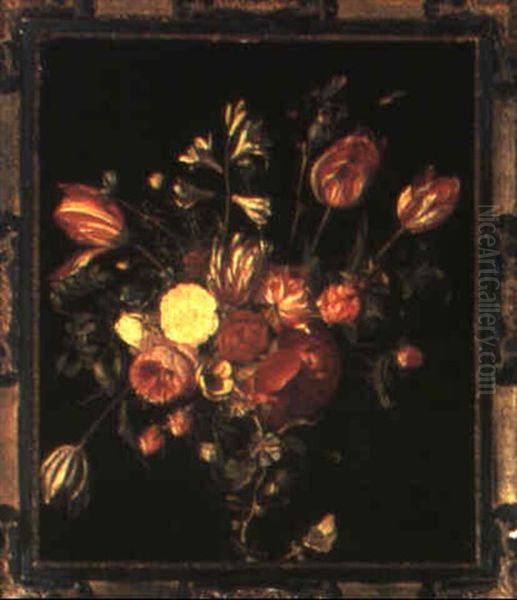
His portrait garlands are also significant. A notable example, rediscovered and restored at the Mauritshuis in The Hague in 2019, features a portrait of the influential Dutch poet and statesman Constantijn Huygens, a known admirer of Seghers' art despite religious differences. Another work, exhibited in Maastricht in 2017, depicted King William III (later King of England) within a floral border, demonstrating the continued demand for such pieces.
Seghers was a meticulous and organized artist. Late in his life, at the age of 71, he compiled a catalogue of his own works, the Catalogus van Bloemstukken, listing 239 paintings he remembered creating, often noting the collaborator for the central image and the recipient or destination of the piece. This invaluable document provides insight into his prolific output, his collaborative network, and the distribution of his art across Europe. It underscores his methodical approach and his awareness of his artistic legacy.
Enduring Influence and Legacy
Daniel Seghers remained active as a painter until shortly before his death in Antwerp in 1661. His influence on Flemish still-life painting was considerable. He successfully carried forward the tradition of flower painting inherited from Jan Brueghel the Elder, refining the garland subgenre and infusing it with deeper religious meaning.
His most important pupil was Jan Philips van Thielen, who closely followed his master's style and specialized in flower garlands, achieving considerable success in his own right. Seghers' work also resonated beyond Flanders. Although primarily active in the Dutch Republic, the Utrecht-born painter Abraham Mignon showed the influence of Seghers' detailed and symbolically rich floral compositions in his earlier works. Seghers' dedication to botanical accuracy and his sophisticated compositions set a high standard for subsequent generations of still-life painters.
His legacy lies in his unique fusion of artistic virtuosity and religious devotion. He demonstrated that specialized still-life painting could convey complex ideas and serve profound spiritual purposes. His collaborative methods highlight the interconnectedness of the Antwerp art world, while his international renown speaks to the universal appeal of his beautiful and meaningful creations.
Seghers in Collections and the Market Today
Works by Daniel Seghers are held in major museums across the world, attesting to his historical importance and enduring appeal. Significant collections can be found at the Museo del Prado in Madrid, the Mauritshuis in The Hague, the Rijksmuseum in Amsterdam, and the Museum Boijmans Van Beuningen in Rotterdam. His paintings are also present in the Vatican collections, the Ateneum Art Museum in Helsinki, the Landesmuseum in Oldenburg, and many other public and private collections.
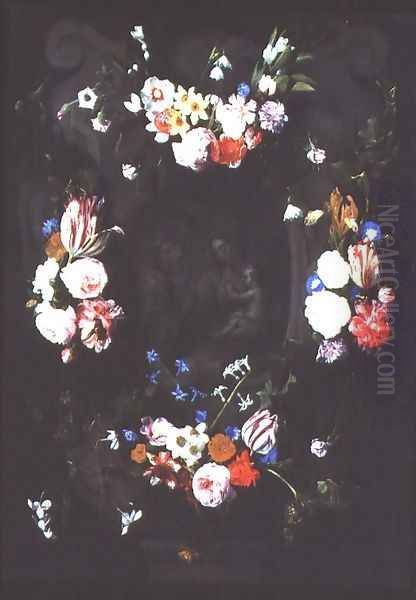
His works continue to appear on the art market, though often infrequently due to their presence in established collections. Auction records, such as the sale of a flower basket still life at Arcimboldo Auctions in 2019 or a still life attributed to him at Floris van Roijen in 2011, indicate continued collector interest. The ongoing research, restoration (like the Huygens portrait at the Mauritshuis), and exhibition of his works ensure that Daniel Seghers remains a recognized and appreciated master of the Flemish Baroque.
Conclusion: The Jesuit Flower Painter
Daniel Seghers occupies a distinct and honored place in the history of art. He was a painter of exceptional technical skill, whose depictions of flowers achieved a remarkable degree of realism and vibrancy. Yet, he was also a man of deep faith, a Jesuit brother who channeled his artistic talents into creating works that celebrated the glory of God's creation and encouraged Catholic devotion during the Counter-Reformation. His mastery of the flower garland, his extensive collaborations with leading artists, and the diplomatic role his paintings played across Europe underscore his significance. More than just a "flower painter," Daniel Seghers was an artist whose life and work uniquely embodied the confluence of art, faith, and culture in the Golden Age of Flemish painting.